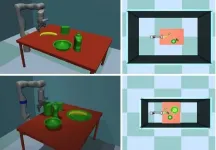Grocery taxes put low-income families at risk for food insecurity
2021-05-26
(Press-News.org) ITHACA, N.Y. - Approximately one-third of all U.S. counties do not exempt grocery foods from the general sales tax, which means the lowest-income families living in those areas are most susceptible to food insecurity. New research from Cornell University finds that even a slight grocery tax-rate increase could be problematic for many.
"An increase of 1% to 4% may sound small, but after several trips to the grocery store, the extra costs can create serious burdens for the lowest-income families," said co-author Harry Kaiser, professor of applied economics and management in the Charles H. Dyson School of Applied Economics and Management. "We found that even the slightest increase in tax rate correlated to an increased likelihood of food insecurity. Grocery taxes that rose by just one percentage point led to a higher risk of hunger in households."
The study focused on sales taxes on foods at retail outlets such as grocery and convenience stores. Kaiser and his co-authors found that, across 14 states, the average grocery tax is just over 4%.
In 2020, grocery food tax policy varied at both state and county levels. A total of 17 states impose grocery taxes, and several states are debating whether to remove or impose taxes. Kaiser's group looked at data from low-income households in the 48 contiguous states plus Washington, D.C., and excluded households with annual income above $30,000.
This threshold was based on the federal poverty level, a measure that accounts for household income relative to household size. For example, in 2017 the poverty level for a single-person household was $12,060; for a two-person household, it was $16,240.
In Alabama, for example, where the grocery tax rate is as high as 9%, the average annual expense in grocery taxes is $630. For households living at or near the poverty level, this tax expense represents a sizeable portion of their household income.
Kaiser's team predicts that the average food insecurity for households with income less than $30,000 will decrease by 3.2% due to the tax removal.
"We hope that by sharing our current data and findings on grocery taxes as it relates to food insecurity," Kaiser said, "policymakers will take a much closer look at the tax burden in certain areas which are hit hardest."
INFORMATION:
The study, "Putting Grocery Food Taxes on the Table: Evidence for Food Security Policy-Makers," published in the journal Food Policy.
ELSE PRESS RELEASES FROM THIS DATE:
2021-05-26
The carefully orchestrated dance between the immune system and the viral proteins that induce immunity against COVID-19 may be more complex than previously thought. A new study by investigators at Brigham and Women's Hospital used an ultrasensitive, single-molecule array (Simoa) assay to detect extremely low levels of molecules in the blood and measured how these levels change over the days and weeks following vaccination. The team found evidence of circulating protein subunits of SARS-CoV-2, followed by evidence of the body mounting its immune response and then clearing the viral protein to below the level of single-molecule detection. Results are published in Clinical Infectious Diseases.
"Because of ...
2021-05-26
Bacteria called methylotrophs can use methane and methanol as fuel; in doing so, they produce large amounts of formaldehyde during growth, but until recently no one knew how they detected and responded to this toxic compound. Publishing on 26th May, 2021 in the Open Access journal PLOS Biology, Christopher Marx of the University of Idaho and colleagues describe their discovery of a novel formaldehyde sensor in the bacterium Methylorubrum extorquens, and other methylotrophs.
Some may remember the pungent smell of this toxic chemical from high school dissections of formaldehyde-preserved animals. From bacteria to humans, all organisms produce at least a little formaldehyde ...
2021-05-26
May 26, 2021, CLEVELAND: According to new findings published in Science Translational Medicine, Cleveland Clinic researchers have identified a promising drug target for treating and preventing aggressive, drug-resistant prostate cancer.
The team, led by Nima Sharifi, M.D., of Cleveland Clinic's Lerner Research Institute, demonstrated that inhibiting the protein H6PD led to significantly reduced tumor sizes and improved survival among mouse models with drug-resistant prostate cancer. The H6PD levels also were elevated in biopsied patient tumors, suggesting the protein might be targeted ...
2021-05-26
Milwaukee, May 26, 2021 - A non-opioid based target has been found to alleviate chronic touch pain and spontaneous pain in mice. Researchers at the Medical College of Wisconsin (MCW) discovered that blocking transient receptor potential canonical 5 (TRPC5) activity reversed touch pain in mouse models of sickle cell disease, migraine, chemotherapy-related pain, and surgical pain.
TRPC5 is a protein that is expressed in both mouse and human neurons that send pain signals to the spinal cord. The findings were published in Science Translational Medicine. The senior and co-first authors of the manuscript, respectively, are MCW researchers ...
2021-05-26
What if a robot could organize your closet or chop your vegetables? A sous chef in every home could someday be a reality.
Still, while advances in artificial intelligence and machine learning have made better robotics possible, there is still quite a wide gap between what humans and robots can do. Closing that gap will require overcoming a number of obstacles in robot manipulation, or the ability of robots to manipulate environments and adapt to changing stimuli.
Ph.D. candidate Jinda Cui and Jeff Trinkle, Professor and Chair of the Department of Computer Science and Engineering ...
2021-05-26
PITTSBURGH, May 26, 2021 - In a paper published today in Science Advances, researchers from the University of Pittsburgh School of Medicine showed that inhalable nanobodies targeting the spike protein of the SARS-CoV-2 coronavirus can prevent and treat severe COVID-19 in hamsters. This is the first time the nanobodies--which are similar to monoclonal antibodies but smaller in size, more stable and cheaper to produce--were tested for inhalation treatment against coronavirus infections in a pre-clinical model.
The scientists showed that low doses of an aerosolized nanobody named Pittsburgh inhalable Nanobody-21 (PiN-21) protected hamsters from the dramatic weight loss ...
2021-05-26
An inhalable nanobody-based treatment may effectively prevent and treat SARS-CoV-2 infections when administered at ultra-low doses, according to a new study in Syrian hamsters. This novel therapy, Pittsburgh inhalable Nanobody 21 (PiN-21), could provide an affordable, needle-free alternative to monoclonal antibodies for treating early infections. Sham Nambulli and colleagues recently developed PiN-21, which uses single-domain antibody fragments that are cheaper to produce than monoclonal antibodies. However, until this study, the efficacy of PiN-21 had not been reported in living organisms. To advance the development of this treatment, Nambulli et al. administered a 0.6 milligram per kilogram ...
2021-05-26
Piscine orthoreovirus (PRV) - which is associated with kidney and liver damage in Chinook salmon - is continually being transmitted between open-net salmon farms and wild juvenile Chinook salmon in British Columbia waters, according to a new genomics analysis published today in Science Advances.
The collaborative study from the University of British Columbia (UBC) and the Strategic Salmon Health Initiative (SSHI) -- a partnership between Fisheries and Oceans Canada (DFO), Genome BC and the Pacific Salmon Foundation -- traces the origins of PRV to Atlantic salmon farms in Norway and finds that the virus is now almost ubiquitous in salmon farms in B.C.
It also shows that wild Chinook salmon are more likely to be infected with ...
2021-05-26
Jodi Karnell and colleagues have developed a monoclonal antibody, VIB7734, that reduces symptom severity in people with cutaneous lupus by targeting and depleting plasmacytoid dendritic cells (pDC) in blood and skin. In two phase I clinical trials involving a total of 67 people with autoimmune diseases such as lupus, treatment with VIB7734 was as safe as a placebo and significantly reduced pDC frequencies, the researchers found. The antibody also reduced the activity of a group of key immune proteins called type 1 interferons in skin. Both pDCs and type 1 interferons are suspected ...
2021-05-26
In the human gut, good bacteria make great neighbors.
A new Northwestern University study found that specific types of gut bacteria can protect other good bacteria from cancer treatments -- mitigating harmful, drug-induced changes to the gut microbiome. By metabolizing chemotherapy drugs, the protective bacteria could temper short- and long-term side effects of treatment.
Eventually, the research could potentially lead to new dietary supplements, probiotics or engineered therapeutics to help boost cancer patients' gut health. Because chemotherapy-related microbiome changes in children are ...
LAST 30 PRESS RELEASES:
[Press-News.org] Grocery taxes put low-income families at risk for food insecurity



